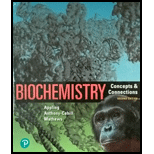
Concept explainers
(a) Interpretation:
If the original molecule is linear or circular should be explained.
Concept introduction:
A restriction enzyme or restriction endonuclease is a protein which can recognize a particular short sequence of
(b) Interpretation:
A map of restriction sites that is consistent with the data should be drawn, indicating the number of bases between restriction sites.
Concept introduction:
A restriction enzyme or restriction endonuclease is a protein which can recognize a particular short sequence of nucleotide and cuts the DNA only at that particular site, which is known as the target sequence or restriction site. Restriction enzymes are given their names after the organisms from which they are isolated. The number of cleavages in the DNA sequence made by a particular restriction enzyme can be determined by the specific number of restriction sites present for that specific enzyme in the DNA fragment. The recognition sequences are randomly distributed all through the DNA. Different species of bacteria make restriction enzymes which have the ability to recognize different nucleotide sequences.
(c) Interpretation:
If there are any other maps that would be consistent with this data should be explained.
Concept introduction:
A restriction enzyme or restriction endonuclease is a protein which can recognize a particular short sequence of nucleotide and cuts the DNA only at that particular site, which is known as the target sequence or restriction site. Restriction enzymes are given their names after the organisms from which they are isolated. The number of cleavages in the DNA sequence made by a particular restriction enzyme can be determined by the specific number of restriction sites present for that specific enzyme in the DNA fragment. The recognition sequences are randomly distributed all through the DNA. Different species of bacteria make restriction enzymes which have the ability to recognize different nucleotide sequences.
(d) Interpretation:
The process used to locate the cleavage sites unambiguously with respect to each other should be explained.
Concept introduction:
A restriction enzyme or restriction endonuclease is a protein which can recognize a particular short sequence of nucleotide and cuts the DNA only at that particular site, which is known as the target sequence or restriction site. Restriction enzymes are given their names after the organisms from which they are isolated. The number of cleavages in the DNA sequence made by a particular restriction enzyme can be determined by the specific number of restriction sites present for that specific enzyme in the DNA fragment. The recognition sequences are randomly distributed all through the DNA. Different species of bacteria make restriction enzymes which have the ability to recognize different nucleotide sequences.
Want to see the full answer?
Check out a sample textbook solution
Chapter 21 Solutions
Biochemistry: Concepts and Connections (2nd Edition)
 BiochemistryBiochemistryISBN:9781319114671Author:Lubert Stryer, Jeremy M. Berg, John L. Tymoczko, Gregory J. Gatto Jr.Publisher:W. H. Freeman
BiochemistryBiochemistryISBN:9781319114671Author:Lubert Stryer, Jeremy M. Berg, John L. Tymoczko, Gregory J. Gatto Jr.Publisher:W. H. Freeman Lehninger Principles of BiochemistryBiochemistryISBN:9781464126116Author:David L. Nelson, Michael M. CoxPublisher:W. H. Freeman
Lehninger Principles of BiochemistryBiochemistryISBN:9781464126116Author:David L. Nelson, Michael M. CoxPublisher:W. H. Freeman Fundamentals of Biochemistry: Life at the Molecul...BiochemistryISBN:9781118918401Author:Donald Voet, Judith G. Voet, Charlotte W. PrattPublisher:WILEY
Fundamentals of Biochemistry: Life at the Molecul...BiochemistryISBN:9781118918401Author:Donald Voet, Judith G. Voet, Charlotte W. PrattPublisher:WILEY BiochemistryBiochemistryISBN:9781305961135Author:Mary K. Campbell, Shawn O. Farrell, Owen M. McDougalPublisher:Cengage Learning
BiochemistryBiochemistryISBN:9781305961135Author:Mary K. Campbell, Shawn O. Farrell, Owen M. McDougalPublisher:Cengage Learning BiochemistryBiochemistryISBN:9781305577206Author:Reginald H. Garrett, Charles M. GrishamPublisher:Cengage Learning
BiochemistryBiochemistryISBN:9781305577206Author:Reginald H. Garrett, Charles M. GrishamPublisher:Cengage Learning Fundamentals of General, Organic, and Biological ...BiochemistryISBN:9780134015187Author:John E. McMurry, David S. Ballantine, Carl A. Hoeger, Virginia E. PetersonPublisher:PEARSON
Fundamentals of General, Organic, and Biological ...BiochemistryISBN:9780134015187Author:John E. McMurry, David S. Ballantine, Carl A. Hoeger, Virginia E. PetersonPublisher:PEARSON





